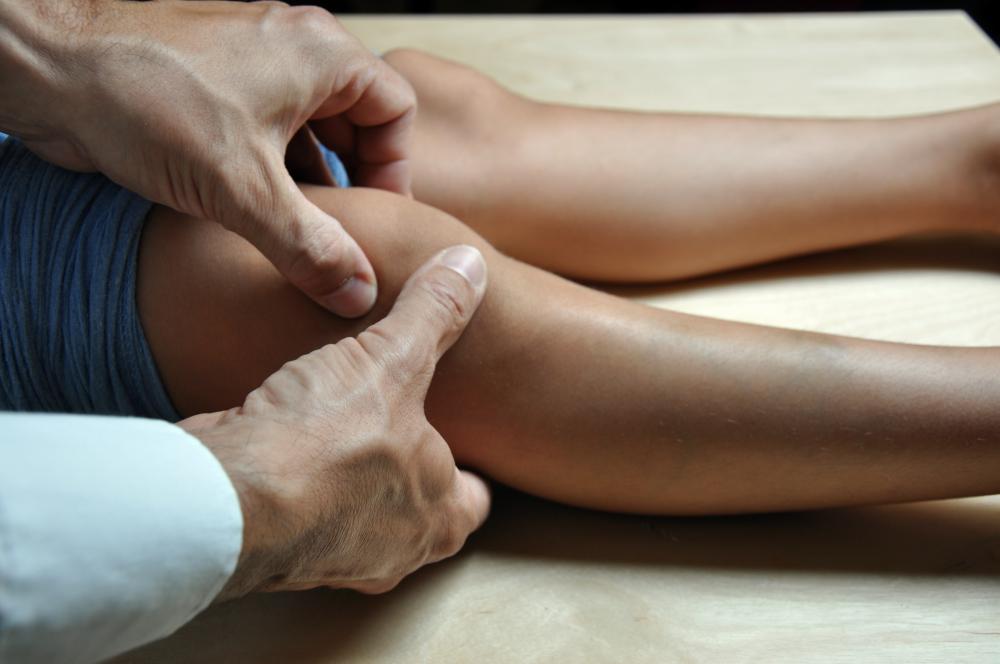At WiseGEEK, we're committed to delivering accurate, trustworthy information. Our expert-authored content is rigorously fact-checked and sourced from credible authorities. Discover how we uphold the highest standards in providing you with reliable knowledge.
What Is the Psoas Sign?
When diagnosing the presence of a medical condition, doctors look for certain signs, such as pain, swelling or redness. Sometimes a problem can result in pain when the body is in a particular position, and Psoas sign is one such example. If a patient feels pain when he or she tries to move the right hip up against pressure applied by a doctor to the right knee, then appendicitis or an abscess may be present.
Many different organs are inside the abdomen, from the stomach to the large intestine. When a person experiences pain in the abdomen, many different conditions can be the cause. Through history and experience, doctors use the presence of a certain type of pain, in a certain location, under specific conditions, to narrow down the cause of the pain. Psoas sign is one of these diagnostic tools.

Commonly, the first step for a doctor when assessing abdominal pain is to gently touch and press on the affected area. After this step, he or she can then move onto more specific tests. In the case of Psoas sign, the doctor puts pressure on the right leg above the knee. The patient then tries to move the right hip against this pressure. If the abdominal pain gets worse when the patient attempts this, then a positive Psoas sign exists.

Appendicitis is one possible diagnosis after a positive Psoas sign. This condition is an inflammation of the appendix, which is a small, empty pouch attached to the digestive system which does not perform essential function, but rather seems to be leftover from prehistoric ancestors of humans. An abscess, which is an inflamed part of the body that contains pus, can also result in a positive Psoas sign.

This sign does not tell a doctor that the patient definitely has appendicitis or an abscess, but makes the diagnosis of one of these conditions more likely than before. Along with Psoas sign, he or she can take into account where the patient feels pain in the abdomen and the type of that pain. Other specific movements, and the results of those movements, can also help diagnose the problem, such as an Obdurator sign, which results in pain when the patient's knee is bent and the right hip is turned inward. As well as diagnostic signs specific to the abdomen, a doctor will also check for the presence of other symptoms, such as temperature, swelling and reduced breathing ability.
AS FEATURED ON:
AS FEATURED ON:















Discussion Comments
@pastanaga - That makes me feel a bit sorry for your friend, because, even if she was being a bit dramatic, gas can really hurt if it gets trapped in the wrong place.
But, it's a good idea to try and be realistic about appendicitis. People know what it is so they suspect every pain in the stomach is going to turn out to be appendicitis, but there are a pretty specific set of symptoms that go with that disease and most of the time people don't have any of them (like pain that starts in one place and moves to another and a fever and vomiting).
The thing is, even though this sign might also be a symptom, you really have to make sure you get professionally diagnosed if you're feeling very ill. Don't just try to find the psoas sign and then figure you don't have anything serious if you don't have it.
@KoiwiGal - I'm not sure it would actually help to know that the person has appendicitis if you are trapped in an elevator together, since the only cure that I'm aware of is surgery and you won't be able to help with that.
But it is a handy thing to know for people who are worried they have appendicitis. I had a friend once who was always convinced she had it and was about to need to go to the hospital, because she often had stomach pains, but one of our science teachers stopped her from complaining so much about it one day. He asked her what side the pains were on and she said it was the left side. Then he told her (quietly, because he didn't want to completely embarrass her) that pain on the left side is usually gas, because the appendix is on the right side.
That really did stop her from complaining!
I'd never heard of this sign before. It's kind of amazing how many different little signals the body can give off if you know what to look for, that show what's the matter with someone. It's one of the reasons I like watching doctor shows, because they often work real medicine into the show.
I know it's a bit silly, but I can't help thinking one day this could come in handy. You never know when you might get stuck in an elevator with someone who has appendicitis.
Post your comments